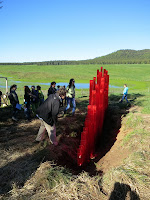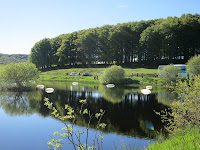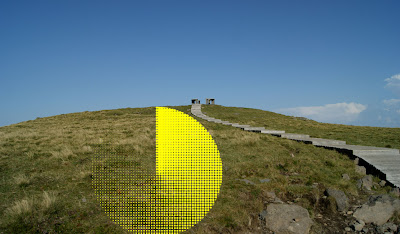Opening Event of Horizons 2013
Thursday 13.6.2013 Opening Event of Horizons 2013
The opening event of Horizons 2013 was
professionally organized with a lot of respect for the artists. I was happy to
find out that the starting point was at Supper
Besse - a classic ski town that was about 10 km away from my place. The
opening day begins with blue sky, without any sign for clouds. It was the
brightest day, despite the weather forecast (for a particularly rainy day).
Don’t worry, the forecaster was right, big time.
Four full buses set off. On schedule: a
full tour from 8:00 am to 8:00 pm. 10 sites on chosen places at Sancy.
 |
| Map of Horizons Installations |
 |
| All about Horizons Installations |
Inauguration
timetable
01
Earth Pulse
Earth Pulse_Besse, les 2
puys
Par Tagit
Klimor, [(israëlienne), Haïfa en Israël]
L : 6,80 m x l : 40 cm x h : 2,30 m
Plaques de polycarbonate rouge translucide
The mayor of Besse
et Saint Anastaise, Mr. André Gay, who is also the mayor of the district, opens
the event. After his speech, a small ceremony is held, something similar to
"cutting the red ribbon", except in this case, the red ribbon is
actually a wooden window, with red curtain that is taken off.


Of course, the installation was revealed to the
eyes of all, on the way to it, but the ceremony was nice and in a good mood.
After the unveiling, I presented my work and concept. An interpreter translated
what I said, since beside a couple of German artist, one spoke French and the
other English, all of the artists were French. I presented the immediate
connection I had with the volcanic sceneries, the will to correspond with the potency
of the volcanic eruption, and the language of the seismic graph representing
the pulse of the earth.
I spoke about the importance of the
environmental approach, the necessity of respecting nature and the need of
being aware, on one hand, to the power of man to hurt nature and on the other
hand, of the mighty power of nature reflected in natural disasters. These are a
reminder of the fragile relationship of man and nature and our limited power and
the urgent need to be humble and respect our environment. The installation
speaks of the vulnerability and the empowerment which simultaneously define
nature.
After the nice informal (in a good way)
ceremony, and later on that day, people came to me and said that they liked my
attitude towards the surrounding and sceneries of the area and especially the
literary idea underlying the installation, that connected the sceneries to the
hidden action of volcanic eruption, they mentioned how well it was integrated
in the landscape and corresponded with
the volcanic history of the site.
My work for today is over. The rest of
the day I enjoyed the journey through breathtaking view and the works of other
artists. The rest of the day is detailed according to the pre-planned schedule.
02
Diatomées mégascopiques_Tourbière de la Barthe (Picherande)_Prisca
COSNIER
Diatomées mégascopiques_Picherande,
tourbière de la Barthe
Par Prisca
Cosnier, [(française), Bretagne]
L : 2 à 3 m x l : 1 m x h : 30 à 40 cm, Superficie : 1000 m²
Polycarbonate compact transparent
Polycarbonate compact transparent
Floating objects on the lake. The water-based installations are
always successful. The view of the small lake with the flora around it and
inside it is a winning recipe. The artist created some kind of floating
transparent amoebas. These “amoebas” are made of transparent Polycarbonate on a
wooden frame and anchored to the bottom. It was very fine and beautiful.
03
Alterburon
Alterburon_Chastreix,
payasage ouvert
Par Collectif
Dérive : James Bouquard et Pierre-Yves Péré
[(français),
Tours et Nantes]
L : 8 m x l : 5 m x h : 4,20 m, Bois : 850 kg, Terre : 14 t
The installation was erected by a French
couple of an architect and a landscape architect, nice and young. It was
obvious to me that the work has a contextual link to architecture. Artists
sometimes use architecture as their own field as in the
case of the Caravan (installation no. 8). Usually in these situations I feel
that students of architecture would do it in a more talented way. In this case
they were not "foreign fields grazed", although in terms of weather
accompanying them, they grazed with a lot of cows nearby.
Their installation is a criticism of
local construction and a question for the need for preservation of tradition.
The work is an abstract house that submerged in the ground. It reminded me of a
house I’d seen once at Etna, Sicily that had sunk in the Lava eruption.
 |
|
House collapsed and covered with lava of Athena volcano eruption
|
The work is composed of a frame of walls
without a roof that creates a room. Two sides
are made of a double wooden envelopes. The other two are meant to be scaffolds
for the mud walls.
The mud walls were
successfully built, but the heavy rain causes the higher wall to collapse. The
"local" mud had return to its origins, into the ground. This duo
started the digging at an early stage. Since their location was covered with
snow, they had to stop their work for some time. They went back and forth few
times, but we have to keep in mind that they live in France, so it is all
relative. Their blog mentions that the ground in very easy to dig, which is a
crucial information for me. First I was afraid that the ground was rocky, and that
the excavation will be difficult.
This duo planned to
return once again in order to rebuild the missing wall.
Flash Loading_Murat-le-Quaire,
la Banne d'Ordanche
Par Marie Lelouche[(française), Marseille]
Par Marie Lelouche[(française), Marseille]
16mx7mx80cm, jalonettes
à disque
An interesting
installation in terms of the concept.
From afar, it seems
like a "flash circle", standing in front of a bald mountain top. The
circle is made out of yellow warning elements that are used to mark roads construction.
The artist planted
them in the ground in a way that it can be seen as different
"pixels". The connection between a common industrial element and its
associating with "digital art" is of interest. From our observation point
it was difficult to assess how it can be seen from a close distance and from
different perspectives. It is a good opportunity to whomever feels like
tracking the area.
In the world of plants..._La Bourboule,
Parc Fenestre
Par Atelier
LandArt : Frank Nordiek & Wolfgang Buntrock, [(allemand),
Hanovre]
L : 10 m x l : 2,5 m x h : 4,5 m, Poids : 500 kg
Superficie : 200 m², Branchages collectés sur place et fils de fer
rouillés
This German duo, who
were very lovely, were the only ones, except for me, who came outside of
France. One of them speaks French, with a very thick German accent, but good
enough in order to get by.
Their original
drawing presented to the competition did not reflect their poetic work. Before I
traveled to France, I saw their work presented in their internet site. I liked
their work and I realized the great potential. They have created many
installation based on weaving "local" twigs and branches by using
metal strings, like the installation in Sancy.
One of their best
work is the "fishbone in the water ":
| http://www.landart.de/1_projekte/011_fisch2.html |
Frank, who is half
of this duo, told me that they actually initiate some of their works, and later
sell the photos. I really enjoyed their work that suggests a dialogue between
elements of the installation that are a kind of a giant vegetable or fruit,
between the installation and the landscape and of course the interaction
between the installation and the people observing it in wonder.
Originally, Frank is
a geologist, who decided to change direction and engage with the art of the
earth. His partner is a landscape architect, who also spends a lot of his time
engaging with art. Frank's father assisted them while preparing the
installation. It took them 2 days to gather the materials and nine days to form
the installation.
Lunch is an important occasion in the local
culture. A big hall, filled with tables and a rich buffet. I was already full
after the first dish (a variety of cheeses), but it was a 3 course meal, so
more to come...
After lunch, we went
back outside and realized that the weather had different plans, and had changed
dramatically. The sky turned grey. The first 5 installations that were
presented in the morning received the best weather conditions. I was fortunate
enough to be one of them.
06
Passage d'horizon
[(français),
Loire]
L : 30 m x l : 10 m x h : 7 m, Superficie : 100 m², Troncs,
Plancher en bois
This installation is
located quite high, and there is a great view from the spot. The installation
itself bursts out of the mountain and creates linear terrace. The installation
is made of logs, Connected by red supportive belts. The material reminds me of
my time in the scouts, where we built all kinds of constructions made out of logs,
which we tied together with ropes. Back then, we didn't considered ourselves as
making an art work.
The real experience
was the rain that accompanied us, and later turned into hail. At this point, I
was so wet, my shoes were filled with water, and I felt as if I was walking in
puddles. Later on, a cloud filled the valley, the installation and us too, as
can be seen in the picture below.
 |
| Walking back in a heavy fog |

07
Natural X.Wing / Sancy contre-attaque
Natural X.Wing / Sancy
contre-attaque_Murol, cratère du Tartaret
Par Guillaume Renou, [(français), Bordeaux]
L : 7,50 m x l : 7 m x h : 10 m,
Poids : 160 kg
Ossature bois, revêtement contreplaqué, câbles acier. Finition peinture et
vernis.
The
pink plane can be related to the issue of femininity or even childhood, which does
have a activist connotation. Besides, the pink and the greenery is very photogenic
and I liked its lightness and dynamics.
Caravane_Saint-Nectaire,
pré de la Pinarde
Par Jean-François Karst, [(français), Rennes]
L : 4 m x l : 2,5 m x h : 2,5 m,
Superficie : 10 m² , Poids : 1700 kg
Briques, plâtre, cornières métalliques, bois.
Les Encorbellements_Saint-Pierre-Colamine,
sommet des Grottes de Jonas
Par Matthieu Pilaud, [(français), Paris
L : 25 m x l : 7 m x h : 3,8 m,
Poids : 2000 kg , Superficie : 160 m², Bois et acier
An interesting
installment, where the construction is located at the edge of the cliff, which
can be seen from afar.
Under the
construction are natural caves which have been transformed into dwelling spaces
and even a praying room. Ancient wall paintings can be found in those cave,
being preserved will over the years.
The installation is made of wooden beams,
connected by steel joints. You get the feeling of abstract caves, made of
"wire frames", which are placed on a natural "stage" on the
range. The installation is quite large - 25 m long, 7 m wide and heights 3.8 m.
it took 7 weeks to build. The installation is very photogenic, and can be
captured from several angles, both from inside and outside.

I wonder whether he used digital tools for its fabrication. The installation has the look of an artisan work
and not a computer-aided design.
Par Michel-Marie Bougard, [(français), Nantes]
L : 50 m x l : 2 m x h : 9 m,
Bambou peint
This is a an impressive installation which already made an
impression at the 3D presentation stage, and kept up its promise.
The work is located
on an old arched roman bridge. The installation creates a light circle made of thin bamboo with
fine joints, painted yellow (what the French have with the yellow?). it seems
as if, between the trees, "sparks" of yellow bamboo are floating from
the ring.
The rods hanging on the tree using fishing wires and cables.
Great job in dealing
with the unique site, using properly the site specifics natural condition.
I loved juxtaposition
of the old and heavy Roman bridge and the new light floating ring.































































































No comments:
Post a Comment